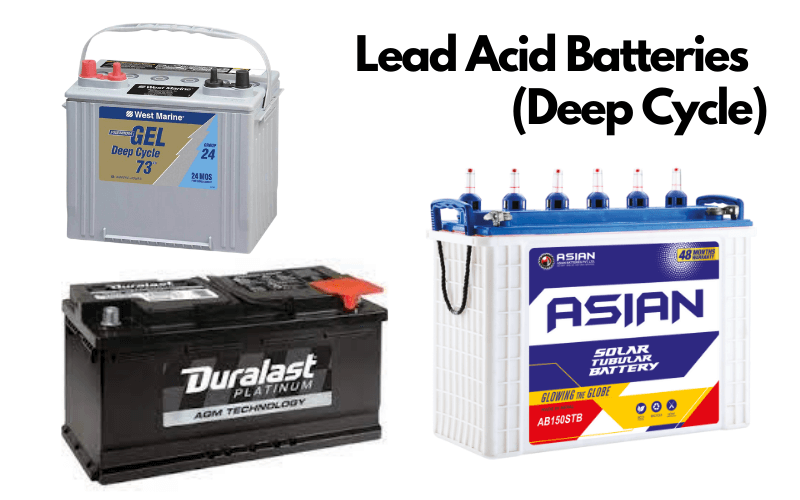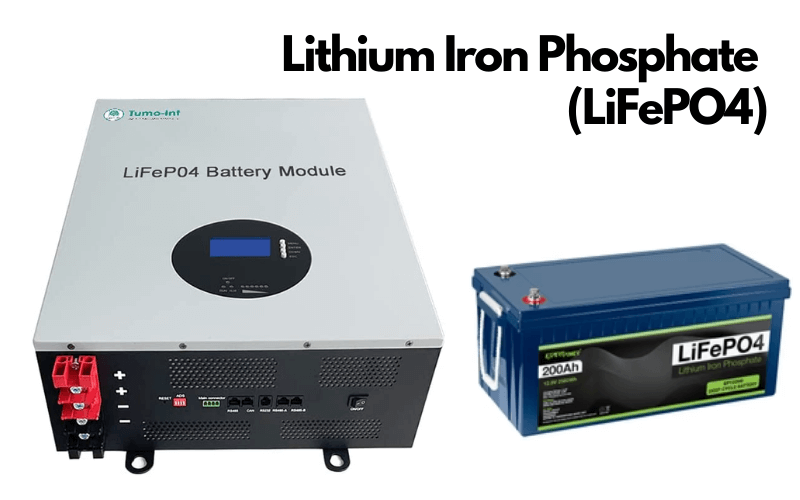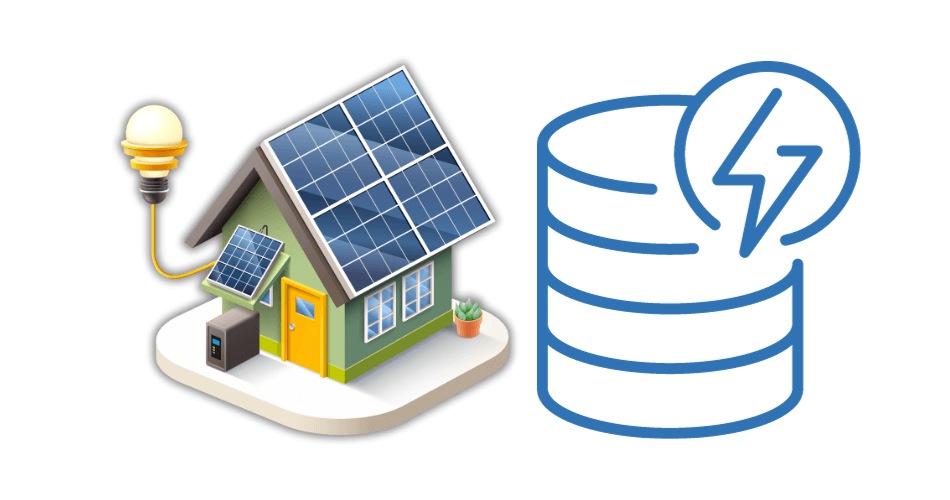Navigating the realm of off-grid living demands an understanding of the critical role that batteries play. This exploration delves deep into the technicalities of various off-grid battery types, each serving a unique purpose in the intricate dance of energy storage and efficiency.
Table of Contents
Lead-Acid Batteries
Lead-acid batteries have been the veterans in the world of batteries since the 19th century, making them the oldest form of rechargeable battery. They’ve powered cars, boats, and many more.
But for off-grids, we need deep cycle versions other than typical lead acid batteries that we use in vehicles. Deep-cycle lead acid batteries come with thicker electrode plates for extended cycle lives.
Their operation hinges on the chemical reaction between lead dioxide (Positive plate), Sponge Lead (Negative plate), and sulfuric acid (Electrolyte).
During the discharge process, the lead dioxide and sponge lead react with the sulfuric acid to create lead sulfate and water, releasing electrical energy. The charging process reverses the same reaction.

Types of Lead-Acid Batteries in Off-Grid Systems
1. Flooded Lead-Acid (FLA):
These are the most common type of lead-acid batteries, often referred to as ‘Wet Cells.’ They require regular maintenance, including monitoring water levels and ensuring proper ventilation for gases released during charging.
- Energy Density (Wh/kg): 30 – 40
- Recommended Max Depth of Discharge- DOD (%): 50
- Lifetime (NO of Cycles): 1000 – 1500
- Self-Discharge Rate (%): 5 – 10
- C rate: 0.4 – 0.8
2. Valve-Regulated Lead-Acid (VRLA):
VRLA batteries, which include AGM (Absorbed Glass Mat) and Gel batteries, are sealed type and require less maintenance than FLA batteries.
AGM Batteries: In AGM batteries, the electrolyte is absorbed in a fibreglass mat. It makes them spill-proof. Also, they have a lower self-discharge rate, which makes them suitable for infrequent use.
- Energy Density (Wh/kg): 30 – 40
- Recommended Max Depth of Discharge- DOD (%): 80
- Lifetime (NO of Cycles): 700 – 1200
- Self-Discharge Rate (%): 2 – 3
- C rate: 0.4 – 0.8
Gel Batteries: These include a Gelified electrolyte, reducing the risk of leakage and spillage. They are more resistant to extreme temperatures and excel in shock and vibration resistance, making them suitable for mobile off-grid systems like RVs or boats. But they are more sensitive to improper charging.
- Energy Density (Wh/kg): 35 – 40
- Recommended Max Depth of Discharge- DOD (%): 80
- Lifetime (NO of Cycles): 1200 – 1500
- Self-Discharge Rate (%): 3 – 5
- C rate: 0.4 – 0.8
Advantages and Limitations:
Durability: These batteries are known for their robustness and ability to deliver high surge currents (Sudden Spike of Current) despite their relatively low energy density. However, it is difficult to supply a continuously high current without dropping voltage because the internal resistance of the Lead-acid batteries is somewhat high compared to others.
Maintenance Requirements: Traditional flooded-type lead-acid batteries require regular maintenance, including checking and topping up electrolyte levels and ensuring they are properly charged to prevent sulfation.
Longevity and Efficiency: Although lead-acid batteries have a shorter lifespan and lower efficiency compared to newer technologies like lithium-iron, proper maintenance can help maximize their service life and performance in off-grid applications.
Choosing Lead-Acid Batteries for Off-Grid Applications
Lead-acid batteries are often chosen for off-grid systems due to their lower upfront cost and reliability. However, their heavier weight, lower energy density, and maintenance requirements are factors to consider. In systems where budget constraints are a significant factor and regular maintenance is feasible, lead-acid batteries can be a viable option.
Led Carbon Batteries:
Lead Carbon battery is a relatively new type of battery which combines the traditional lead-acid chemistry with supercapacitor technology, offering some unique advantages.
Lead Carbon batteries are an innovative hybrid. They incorporate Carbon material into the negative electrode alongside the traditional lead-acid composition. This addition of Carbon significantly enhances the performance of the battery, particularly in terms of cycle life and charge acceptance.
- Energy Density (Wh/kg): 35 – 45
- Recommended Max Depth of Discharge- DOD (%): 80
- Lifetime (NO of Cycles): 1500 – 2000
- Self-Discharge Rate (%): 1 – 2
- C rate: 0.5 – 1
Technical Advantages:
Extended Cycle Life: The integration of carbon reduces the rate of sulfation, which is a common cause of failure in lead-acid batteries. This results in a longer cycle life compared to standard lead-acid batteries.
Improved Charge Acceptance: Lead Carbon batteries can accept a charge more rapidly than traditional lead-acid batteries. This is particularly beneficial in off-grid systems relying on intermittent power sources like solar or wind, as it allows for quicker energy storage when conditions are favourable.
Enhanced Stability: The addition of carbon stabilizes the battery’s internal chemical reactions, making it more resilient to partial state of charge (PSOC) operations. This is a typical scenario in renewable energy systems where batteries frequently operate without being fully charged.
Resilience to High Temperatures: These batteries exhibit improved performance in high-temperature environments, a notable advantage in outdoor or non-climate-controlled settings.
Considerations for Off-Grid Applications
While Lead Carbon batteries present these technical benefits, they still inherit some characteristics from their lead-acid heritage. They are heavier and have a lower energy density compared to others. However, their improved lifespan and stability under varying charge conditions make them compelling off-grid battery storage, especially in scenarios where budget and durability are key considerations.
Lithium Batteries
Have you heard about lithium batteries? Chances are, you have! These are the same types of batteries powering your smartphones and laptops. But when it comes to off-grid battery banks, they’re a game-changer.
Lithium batteries function on the principle of Lithium ions moving between the Anode and Cathode when charging or discharging. This ion transfer is facilitated by an electrolyte and a separator that prevents direct contact between the electrodes, thereby avoiding short circuits.
- Energy Density (Wh/kg): 100 – 230
- Recommended Max Depth of Discharge- DOD (%): 80
- Lifetime (NO of Cycles): 1000 – 2000
- Self-Discharge Rate (%): 2 – 3
- C rate: 1 – 1.5
Core Features:
Energy Density: Lithium-ion batteries boast a high energy density, allowing them to store more energy in a smaller footprint. This quality makes them an attractive option for space-conscious off-grid setups.
Recharge Efficiency: These batteries excel in their ability to rapidly recharge, a valuable attribute in off-grid systems where capturing energy efficiently during limited windows (like daylight hours for solar) is crucial.
Temperature Tolerance: They demonstrate remarkable performance under varying temperature conditions, maintaining efficiency in both hot and cold environments.
Advantages of Lithium-Ion Batteries in Off-Grid Settings
Longevity and Durability: Lithium-ion batteries are known for their long service life, which is a critical consideration in off-grid installations where frequent battery replacement is impractical.
Minimal Maintenance: Unlike some traditional battery technologies, Lithium-Ion batteries require little to no maintenance, making them a convenient choice for remote or inaccessible off-grid locations.
Environmental Impact: Lithium-ion batteries are more environmentally friendly than lead-acid and nickel-based alternatives. But they still lag behind LiFePO4 batteries in terms of eco-friendliness.
Considerations for Implementing Lithium-Ion Batteries in Off-Grid Systems
While Lithium-Ion batteries present many advantages, they also come with a higher initial investment compared to other types. However, their longevity and efficiency can lead to cost savings over time.
Additionally, it is essential to ensure compatibility with the existing system components, such as inverters and charge controllers, for optimal performance. If you are going to set up a DIY off-grid lithium battery bank, make sure to add a BMS for the controlled charging of each battery cell.
Lithium Iron Phosphate (LiFePO4)
Lithium Iron Phosphate Batteries are the cousins of Lithium batteries but with a green twist. They operate similarly to standard lithium batteries but use lithium Iron Phosphate as the cathode material. This composition facilitates a more stable and safer electrochemical performance.
They’re not just eco-friendly; the best of these batteries is their thermal stability and safety, with a reduced risk of overheating.
- Energy Density (Wh/kg): 90 – 180
- Recommended Max Depth of Discharge- DOD (%): 80
- Lifetime (NO of Cycles): 3000 – 6000
- Self-Discharge Rate (%): 1 – 2
- C rate: 1 – 1.5
Advantages:
Enhanced Safety: The LiFePO4 chemistry is inherently more stable and less prone to overheating or thermal runaways, a common safety concern with standard lithium-ion batteries.
Long Cycle Life: One of the standout features of LiFePO4 batteries is their impressive cycle life. They can endure thousands of charge-discharge cycles with minimal capacity degradation.
Steady Discharge and Charge Rates: LiFePO4 batteries provide consistent power output throughout their discharge cycle and can handle high charge and discharge currents. This makes them highly efficient in scenarios where rapid charging or high-power output is required.
Environmental Sustainability: These batteries are free from cobalt, a metal associated with environmental and ethical concerns. The use of iron phosphate, a more abundant and less toxic material, contributes to their eco-friendly profile.
Considerations:
While LiFePO4 batteries offer numerous benefits, they come with a higher upfront cost compared to traditional lead-acid batteries. However, their extended lifespan and lower maintenance requirements can lead to cost savings over time.
LiFePO4 in Off-Grid Applications

Why Choose LiFePO4 for Off-Grid Systems? LiFePO4 batteries are particularly well-suited for off-grid systems due to their balance of efficiency, durability, and safety. Their ability to withstand deep discharge cycles makes them ideal for storing energy from intermittent renewable sources like solar or wind. Additionally, their long lifespan and low maintenance needs align well with the practicalities of off-grid living.
Nickel-Cadmium (NiCd) Batteries
NiCd batteries are known for their durability. They can take a beating and still keep going, making them a reliable choice in harsh conditions.
In NiCd batteries, the anode is made of cadmium, and the cathode of Nickel Oxide Hydroxide. They use an Alkaline Electrolyte, usually Potassium Hydroxide. During discharge, the Cadmium and Nickel Oxide are chemically transformed, which generates electric power.
They exhibit remarkable performance in extreme temperatures like cold weather, where other batteries might throw in the towel.
But they have some downsides. The memory effect can diminish their efficiency over time, and the presence of Cadmium, which is a toxic heavy metal, poses environmental concerns.
Choosing the Right Battery for Your Off-Grid Adventure
So, which battery should you choose for your off-grid escapade? It boils down to what you need and what you value. If you’re looking for something lightweight, long-lasting, and eco-friendly, lithium or LiFePO4 batteries are your best bet. They might be pricier upfront, but they’ll be your loyal companions for years.
If you’re setting up in a challenging environment and need something tough and reliable, NiCd batteries might be your go-to. But remember, they need careful handling due to their environmental impact.
For those on a tighter budget or with less demanding energy needs, Lead-acid batteries can be viable options. They offer a good balance between cost and performance, though they do come with higher maintenance requirements. Just choose the type that fits your lifestyle – flooded, gel, or AGM.
In the case of Lead Carbon batteries, they offer a promising middle ground between traditional lead-acid batteries and more advanced technologies like lithium-ion. Their enhanced cycle life, better charge acceptance, and resilience make them a noteworthy option for those seeking a balance between cost, performance, and longevity in their off-grid power systems.
Conclusion: Powering Your Off-Grid Dreams
In conclusion, the right battery choice depends on individual needs, budget, and the specific conditions of the off-grid setup. Whether it’s the high-efficiency lithium variants, environmentally conscious LiFePO4, resilient NiCd, or the traditional lead-acid types, each battery brings its unique set of attributes to the table.

In my experience of living off-grid, the choice of the battery is a critical decision that impacts not just the efficiency but also the sustainability of your energy system. Personally, I recommend Lithium Iron Phosphate Batteries.
When selecting the ideal battery for an off-grid system, it’s essential to weigh these technical aspects against the specific requirements of your setup. Understanding the internal workings of these batteries not only aids in making an informed decision but also ensures the longevity and efficiency of your off-grid energy system.
Whichever type you choose, ensuring proper maintenance and usage according to manufacturer guidelines will maximize both performance and lifespan, making your off-grid adventure both sustainable and rewarding.
